Archives
-
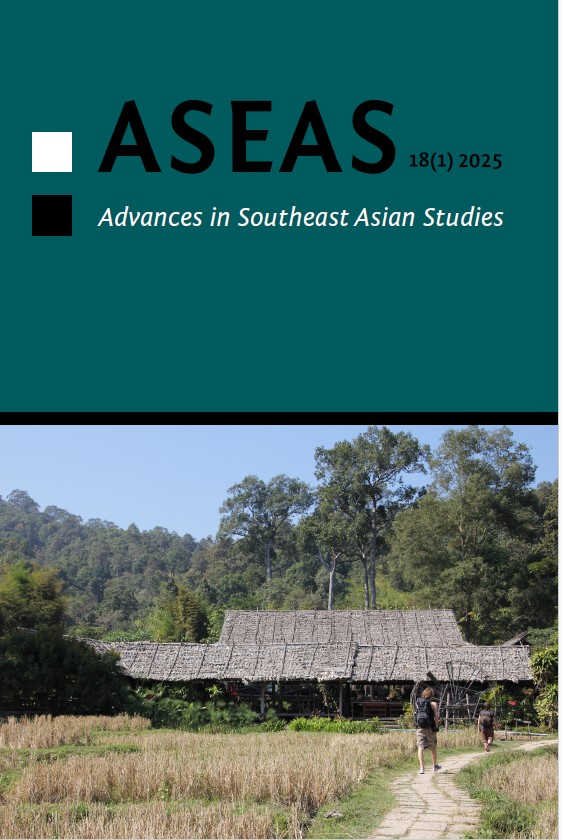
Vol. 18 No. 1 (2025)
ASEAS 18(1) presents a diverse collection of research articles, workshops, and book reviews, centered around three key themes: sustainability, governance, and conflict. The issue covers four countries in Southeast Asia – Laos, Indonesia, Thailand, and Singapore – offering insights into emerging regional issues. Sustainability is explored through the lens of tourism, service quality, and food consumption practices. Governance is examined via China’s role in Laos’ hydropower sector and the use of political memes in Indonesia, revealing shifts in political communication. Conflict is analyzed through the role of language in Indonesia, emphasizing its power to reinforce social hierarchies. Complementary book reviews expand on themes of identity and political transformation in Southeast Asia, enriching the issue’s broader geographical and thematic scope.
Managing Editors
Alexander Trupp & Prachi Thakur
Cover Photo
Kosita Butratana
Layout
Karl Valent
-
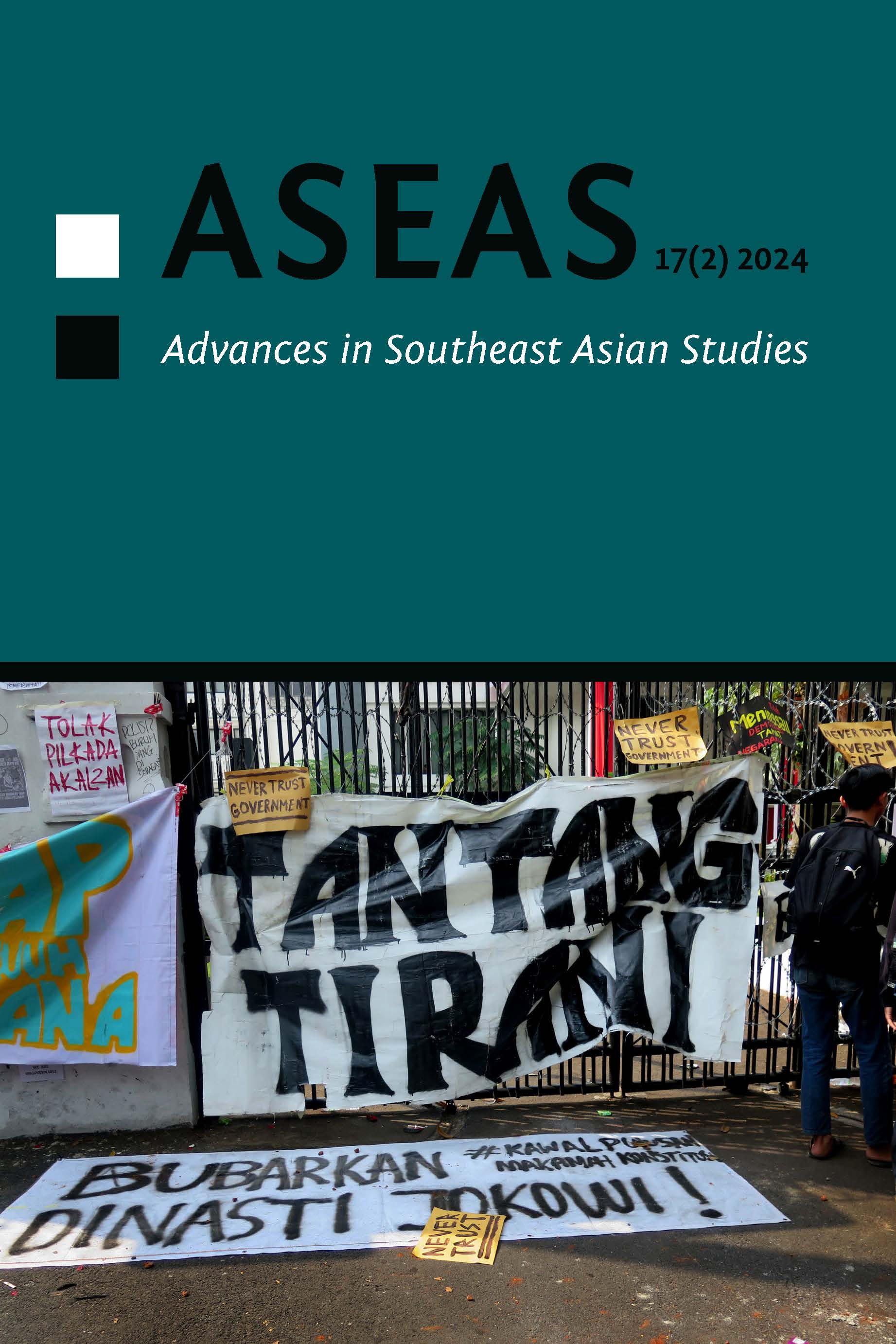
Vol. 17 No. 2 (2024)
ASEAS 17(2) presents a thematically open collection of articles, marking the second issue under our new publication scheme. The contributions span three overarching themes: (Sustainable) Tourism and Material Culture Studies; Social and Political Activism; and International and Interregional Political and Economic Intersections (Historical and Contemporary). Geographically, the articles cover a range of countries including Vietnam, the Lao People’s Democratic Republic, Thailand, Indonesia, Malaysia, and the Philippines.
Managing Editor
Lukas Christian Husa
Cover Photo
Frans Ari Prasetyo
Layout
Karl Valent
-
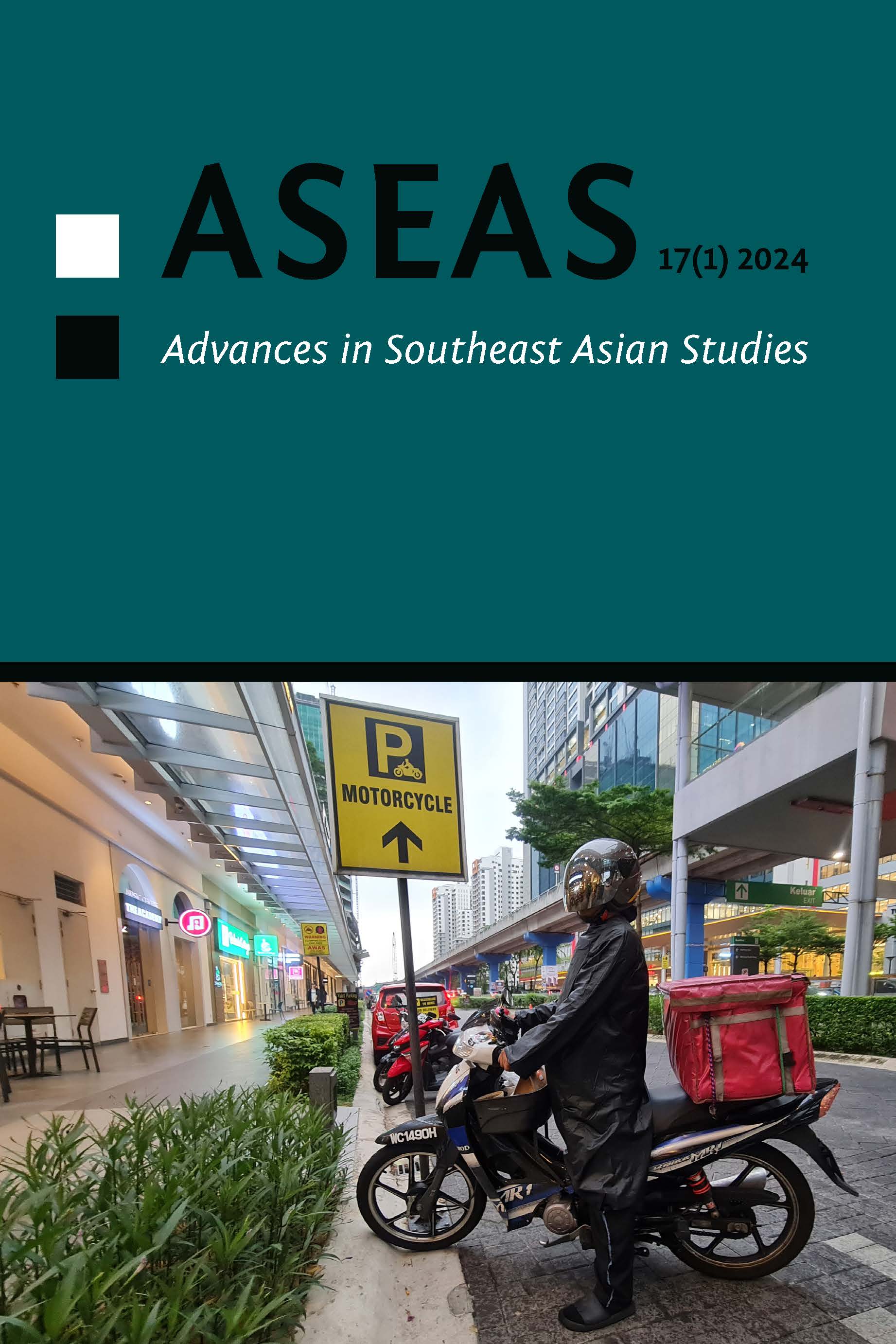
Vol. 17 No. 1 (2024)
In ASEAS 17(1), we feature a thematically open collection of contributions covering such diverse aspects as philanthropy in Indonesia, issues in the context of Papua’s special autonomy, digital intimacies in Indonesia, press freedom in the Philippines, and health and safety challenges in Southeast Asia’s gig economy food delivery sector. Additionally, this issue marks a new phase for the journal with adjusted publication timelines, now releasing issues in March/April and September/October, while maintaining our Online First feature.
MANAGING EDITORS
Alexander Trupp & Dayana Lengauer
COVER PHOTO
Kosita Butratana, 2024 (Malaysia, Sunway City, food delivery rider)
LAYOUT
Karl Valent
-

Negotiating Chinese Infrastructures of Modern Mobilities: Insights from Southeast Asia
Vol. 16 No. 2 (2023)From transportation to urbanization, energy and digitalization, China-backed projects of infrastructural development are increasingly common throughout Southeast Asia and the global South as both a means and outcome of development. This trend has accelerated since China’s Belt and Road Initiative (BRI) in 2013. Against this backdrop, the present ASEAS issue invites to rethink the roles infrastructure plays in forms of development that place connectivity at the center.
Exploring how the dialectics of infrastructure and mobility manifests itself on the ground, this special issue features five empirical case studies which address various mobility infrastructures in the Thailand-Laos borderlands, Vietnam, Thailand, Myanmar, and Cambodia. These five current research articles are complemented by two research workshop articles, which critically assess the conceptual linkage between infrastructures and mobility in the Chinese context. Taken together, these contributions complicate and complete the understanding of China’s BRI and notions of global China in general. In particular, they show how visions and designs, or promises, of infrastructure cause both intended and unintended mobilities, or plainly immobilities or forced displacements, while they also mobilize, and are mobilized by, various actors with their potential interests, aspirations, skepticism, and resistance.MANAGING EDITOR
Simon RowedderGUEST EDITORS
Phill Wilcox & Susanne BrandtstädterCOVER PHOTO
Simon Rowedder, 2019 (Laos, Oudomxay Province, construction of the China-Laos Railway)LAYOUT
Karl ValentLANGUAGE EDITING
Daniel Brown -

The COVID-19 Pandemic, (Im)Mobilities, and Migration in Southeast Asia
Vol. 16 No. 1 (2023)The present issue of ASEAS features a focus on the effects of the COVID-19 pandemic on mobility and migration in and between Southeast Asian countries, assessing past, current, and future trends as well as its cultural, social, economic, ecological, and political implications. As many other regions in the world, Southeast Asian countries have been hit hard by the COVID-19 pandemic. Although most countries managed to cope relatively well with the first wave in 2020, subsequent waves saw rising death tolls and immense pressures on the region’s health and welfare systems. At the same time, travel restrictions and local as well as national lockdowns affected migrant populations disproportionally as hundreds of thousands got stuck in either their countries of origin or destination countries with little or no alternative means of making a living. This special issue presents six empirically grounded case studies (four current research and two research workshop articles) that address the COVID-19-migration/mobility nexus in Myanmar, Malaysia, Indonesia, Thailand, and Australia. Articles outside this special issue focus address topics of hazard related vulnerability and coping strategies in the Philippines as well as the media consumption/travel motivation nexus in the Philippines regarding Thailand.
MANAGING EDITOR
Gunnar StangeGUEST EDITOR
Antje MissbachCOVER PHOTO
Claudia Dolezal, 2023 (Thailand, Bangkok, Suvarnabhumi Airport)LAYOUT
Karl ValentLANGUAGE EDITING
Daniel Brown -

Challenging Stereotypes in Europe-Thailand Transnational Migration
Vol. 15 No. 2 (2022)The migration flows connecting Thailand and Europe have constructed social spaces in which different stereotypes regarding Thais and Europeans emerge, perpetuate, and circulate, thereby affecting to various extents the lives of these individuals. To challenge these stereotypes, the present issue takes into account the mechanisms of social categorization at transnational and local dimensions in three critical steps. First, it adopts an inclusive stance by not limiting itself to heterosexual relationships involving Thais and Europeans. Second, it shifts the scholarly gaze from marriage and family issues to Thai migrants’ mobilities in spatial, social, and intergenerational terms. And third, it highlights Thai migrants’ engagement in the labor market as intimate workers and entrepreneurs to uncover the factors shaping their (re)productive labor and social incorporation in their receiving countries. Using an intersectional approach, this special issue presents six empirically grounded case studies to unveil often-neglected dimensions and complexities of Europe-Thailand transnational migration. Articles outside the special issue focus address topics of community-based tourism in Brunei Darussalam and inclusive development in the context of a festival in Malaysia.
MANAGING EDITORS
Alexander Trupp & Rainer EinzenbergerGUEST EDITORS
Asuncion Fresnoza-Flot & Sirijit SunantaCOVER PHOTO
Sirijit Sunanta, 2022 (Thailand, Hua Hin, Soi 94 in the evening)LAYOUT
Karl ValentLANGUAGE EDITING
Daniel Brown -

Vol. 15 No. 1 (2022)
ASEAS 15(1) launches the first issue of the Journal under its new title, Advances in Southeast Asian Studies. It features a thematically open collection of contributions covering legal issues, historical discourses, and contemporary developments in the region. Drawn from various perspectives, the contributions scrutinize legal regulations, such as, on the placement and protection of Indonesian migrant workers and on agricultural land appropriation in Vietnam, provide gendered analysis on knowledge production, and examine prospects of poverty alleviation of low-income households in Indonesia and remote fishing communities in the Philippines.
MANAGING EDITORS
Dayana Lengauer & Richard S. AquinoGUEST EDITORS
Vissia Ita Yulianto, Muhadi Sugiono & Hakimul IkhwanCOVER PHOTO
Alexander Trupp, 2008 (Pangandaran, Indonesia)LAYOUT
Karl ValentLANGUAGE EDITING
Daniel Brown -

Multicultural Lingual and Multicultural Education
Vol. 14 No. 2 (2021)Countries in Southeast Asia share the same characteristics of being ethnically and culturally diverse. Indonesia alone, for example, has as many as 300 ethnic groups who speak 240 different languages. Cambodia, with its relatively small population of 16 million, has 36 ethnic and linguistic minorities. To keep a balance between unity and diversity is a challenge that countries in the region share. Compared to the present time, the management of cultural diversity was not an issue in the past. In all Southeast Asian countries, ethnic, religious, and cultural diversity has been perceived as a threat to national unity, and education is one of the tools they have used to unify people. Mono-cultural education policies, such as the prohibition of other languages in schools, a centralized curriculum, and the closing of schools set up by ethnic and religious groups, were implemented across countries in the region. These policies deprived ethnic groups and indigenous people of their cultural practices and identities. The result was resentment, marginalization, and at times, persistent conflicts. In recent years, transnational migration around the region has become remarkable, making the issue of cultural diversity even more complicated. ASEAS 14(2) focuses on the movements to reclaim linguistic and cultural rights that have been initiated across countries in the region and examines contemporary issues resulting from the transnational flow of people around Southeast Asia.
Managing Editor: Lukas C. Husa
Guest Editor: Thithimadee Arphattananon
Language Editor: Daniel Brown
Cover Photo: K. Husa, 2013
Layout: Karl Valent
-
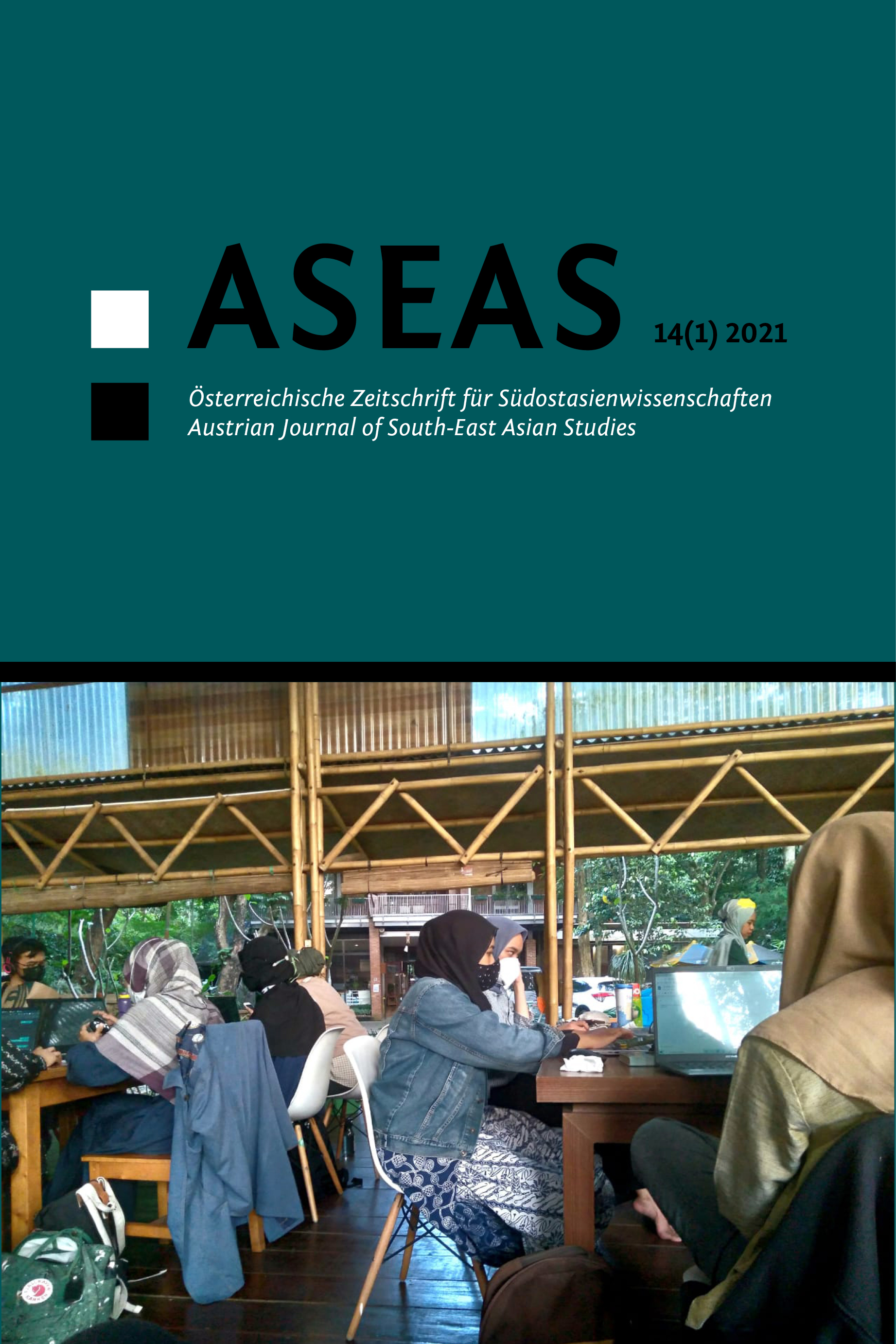
Vol. 14 No. 1 (2021)
ASEAS 14(1) features a thematically open issue on recent developments in Southeast Asia, ranging from qualitative case studies to wider political and socio-economic dynamics in the region. The articles cover current developments in Thailand, Vietnam, Malaysia, and Indonesia, but the analyses presented transcend national borders, for example, in terms of transnational movements or the COVID-19 pandemic, and discuss related uncertainties and prospects.
Managing editors: Timo Duile & Dayana Lengauer
Guest editor: Wolfram Schaffar
Cover Photo: Issaiah Fanny Alam
Layout: Karl Valent
-

Negotiating Transdisciplinarity
Vol. 13 No. 2 (2020)Humanity and nature around the globe are facing increasingly complex and interdependent challenges, which require not only rapid action and structural change, but presumably a more inclusive research framework and a pluralistic concept of knowledge. This issue critically engages with transdisciplinarity, and more precisely with a transdisciplinary capacity building project in Southeast Asia and Europe funded by the Erasmus+ Capacity Building in Higher Education program. The aim of the project was to develop and consolidate transdisciplinary capacities for teaching and research focussing on three global challenges: migration, natural resources, social inequality. The present issue offers a selection of reflections, theoretical and conceptual groundings, and empirical embeddings of the experiences and outcomes of the project. The authors, all centrally involved in the project, illuminate different aspects of the joint endeavor, and raise questions regarding collaboration and transformative action in very diverse settings marked by multiple inequalities. The papers address not only epistemological problems, but also administrative and managerial challenges of such a project, as well as the clashes between research and capacity-building aspects in scientific activity. They also elaborate on disciplinary and cultural obstacles and hurdles of intellectual belonging and difference. The issue, thus, forges a bridge between theoretical reflexions on transdisciplinarity and concepts of knowledge on the one hand, and its institutional, structural, and disciplinary encounters, on the other.
Managing editors: Rainer Einzenberger, Gunnar Stange, & Dayana Lengauer
Guest editors: Petra Dannecker & Alexandra Heis
Cover Photo: Michaela Hochmuth
Layout: Karl Valent
-
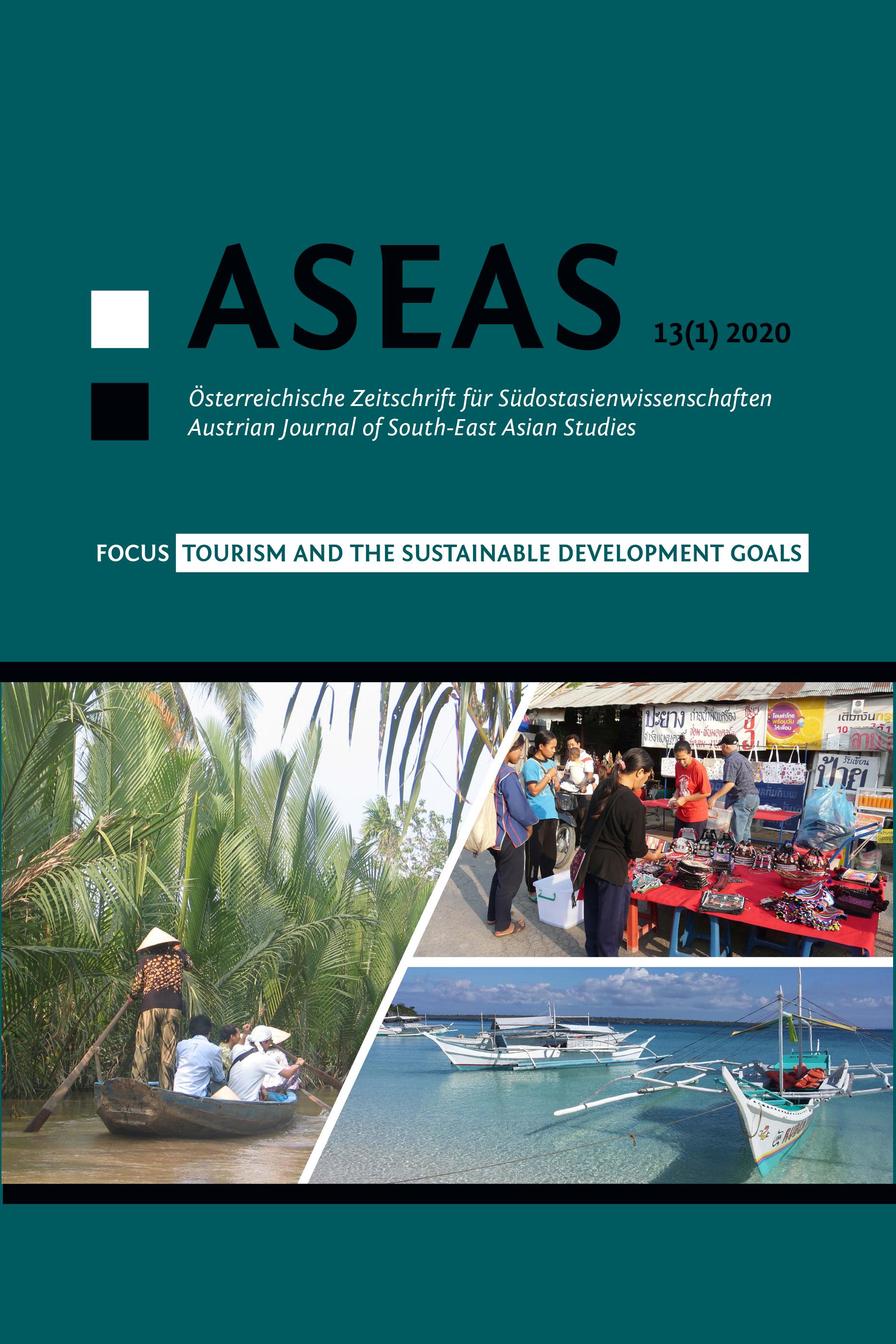
Tourism and the Sustainable Development Goals
Vol. 13 No. 1 (2020)The UN Sustainable Development Goals (SDGs), a set of 17 goals agreed on as an extension of the previous Millennium Development Goals (MDGs) in 2015, are significantly shaping the current development agenda until the year 2030. ‘Agenda 2030’ has moved the development debate beyond an economic focus towards understanding development as more multi-dimensional than ever before. Tourism thereby is regarded to make a substantial contribution, explicitly linked to goals number 8, 12, and 14 – particularly given its economic role it plays in the Global South, also in the region of Southeast Asia. At the same time, tourism bears an often under-utilized potential to contribute to the entire set of the 17 goals, moving beyond economic empowerment towards health, environmental conservation, climate change efforts, education, gender equality, and more. Its relationship with sustainable development is often regarded as precarious, though, since its negative impacts and conflicts between different actors and stakeholders cannot be overlooked. Particularly with regard to the SDGs, little research exists to date that investigates if and how tourism can contribute to reaching the targets set out in the goals in order to achieve a more sustainable development in the future. This issue, therefore, discusses the role that tourism plays in the achievement of the SDGs in Southeast Asia, particularly at a time when the region, and the industry at large, have been strongly impacted by the global health crisis caused by COVID-19. The articles in this issue feature contributions focusing on local tourism businesses and resilience, volunteer tourists as potential ‘agents of change’ for the SDGs, community-based tourism (CBT) and language, willingness to pay in CBT, as well as smart and sustainable tourism cities in Southeast Asia – while also creating an indispensable link between tourism and the SDGs.
Managing editors: Claudia Dolezal & Alexander Trupp
Cover Photos: Kosita Butratana & Alexander Trupp
Layout: Karl Valent
-
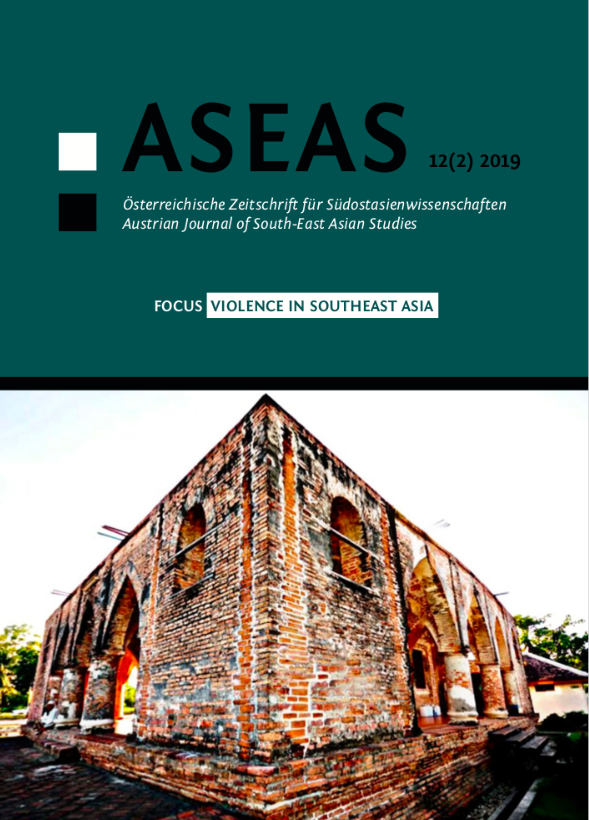
Violence in Southeast Asia
Vol. 12 No. 2 (2019)Rampant forms of violence increasingly take place not only in troubled areas but also in centers and metropoles. Such violence is no longer simply confined to local concerns or historical ruptures, but emerges instead in relation to modalities of power. The movement of people and expanding networks of actors and capital enables the notion of violence to transgress boundaries set by institutions, geography, state, and power. In some conditions, rather than sealing off the emergence of violence, the transition to democracy has opened the door for engineered violent confrontations to manifest out of cleavages that have been tempered by previous authoritarian rule. ASEAS 12(2) addresses violence in selected cases and on different scales. The contributions discuss how violence is practiced, how it (re)produces structures, and how it may eventually transform into non-violence. Violence is not simply an outcome of tensions but is a mechanism that actors and organizations deploy to stabilize their struggles, which eventually makes peacebuilding or democratic projects volatile. The articles in this issue feature police violence in the Philippines; intimate partner violence against women in Vietnam; Islamist online/offline mobilization strategies in Indonesia; the role of traditional actors in reconciliation processes in Timor-Leste; and gender security in the context of conflict management in Thailand’s Deep South.
Managing Editor: Gunnar Stange
Guest Editors: Ario Seto, Susanne Schröter
Cover Photo: Mahamayakee Waeso, Krue Ze Mosque, Pattani, Thailand, 10 October 2012
Layout: Karl Valent
-

Vol. 12 No. 1 (2019)
ASEAS 12(1) features a thematically open issue on recent developments in Southeast Asia, ranging from qualitative case studies to wider socio-economic, political, and cultural dynamics in the region. The articles cover developments in Myanmar, Thailand, Malaysia, Indonesia, Vietnam, and Cambodia, but the analyses transcend national borders and also discuss, for example, the rising influence of China in Southeast Asia.
Managing Editor: Melanie Pichler
Cover Photo: Karl Valent
Layout: Karl Valent
-

Forced Migration
Vol. 11 No. 2 (2018)The current issue of ASEAS, 11(2), discusses the highly relevant topic of forced migration in Southeast Asia. Historically, the region is known for the so called boat people crisis in the aftermath of the Vietnam War between 1975 and mid 1995, when almost 800,000 Vietnamese fled their country by sea in fear of prosecution. Currently, Southeast Asia is experiencing its second major forced migration crisis with nearly one million Rohingya people who fled Myanmar in fear of an ongoing genocide committed by the Armed Forces of Myanmar. Thus far, we know little about the current state of refugees and internally displaced persons in Southeast Asia. There are only estimates available on the actual number of people that migrate involuntarily to or within the region. However, according to UNHCR estimates, 3.37 million of the 68.5 million forced migrant population worldwide were hosted by Southeast Asian countries in 2017. At the same time, Southeast Asia has one of the weakest protection frameworks for refugees and asylum seekers worldwide. Only Cambodia, the Philippines, and Timor-Leste have ratified the 1951 Refugee Convention and its 1967 protocol. Contributions to this issue include two case studies from Indonesia focusing on refugee self-organization and the local politics of hospitality towards refugees respectively, and one article that scrutinizes the politics of refugees and asylum seekers registration in Malaysia and Thailand.
Guest Editors: Gunnar Stange & Patrick Sakdapolrak
Managing Editor: Gunnar Stange
Cover Photo: Boat Refugee in Aceh, Indonesia (photo by Antje Missbach)
Layout: Karl Valent
-
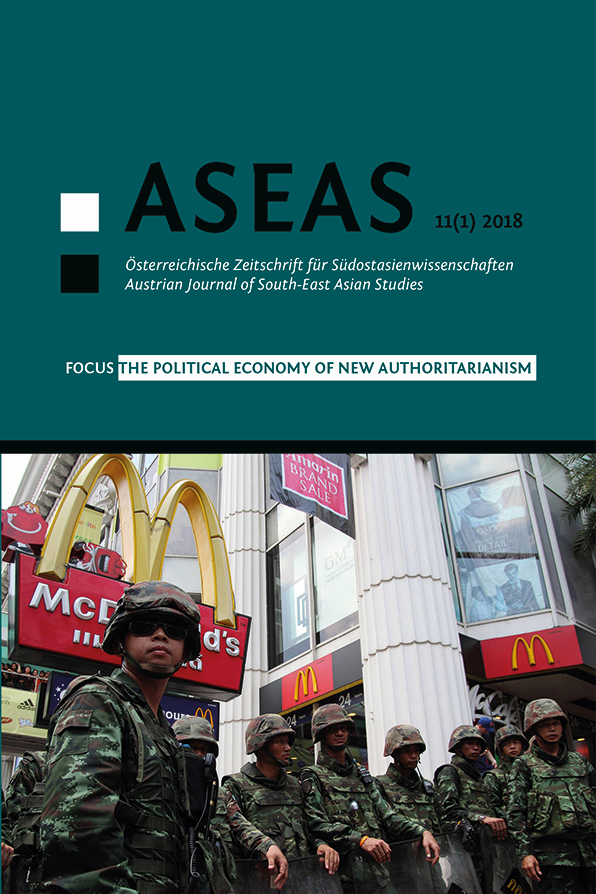
The Political Economy of New Authoritarianism
Vol. 11 No. 1 (2018)New authoritarianism has become a global phenomenon over the past years, and Southeast Asia is no exception to this trend. The current issue of ASEAS 11(1) discusses the rise of authoritarianism in the region from a political economy perspective. It raises questions about the connection between economic crises and the rise of authoritarian regimes, as well as the specific kinds of economic projects that authoritarian regimes pursue. The articles in this issue include an analysis of a Chinese mining project in Myanmar’s frontier region as well as a re-interpretation of Thailand's military coup in 2014 against the background of China's Belt-and-Road Initiative and the changing economic world system. Other contributions analyze the continuity and intensification of Malaysia's neo-liberal development paradigms, and the role and potential of National Human Rights Institutions in big transnational infrastructure projects. The articles illustrate not only facets of persistent authoritarian neoliberalism, but they also highlight the dawn of a new Chinese-centered accumulation cycle in world history. They reveal transnational mechanisms of primitive accumulation as well as sophisticated transnational institutionalization processes for the defense of human rights. It becomes clear that any response to new authoritarianism will need transnational cooperation and include a search for more fundamental economic alternatives.
Managing Editor: Rainer Einzenberger
Guest Editors: Wolfram Schaffar, Rainer Einzenberger, Carl Middleton, Naruemon Thabchumpon
Cover Photo: Nick Nostitz
Layout: Karl Valent
-
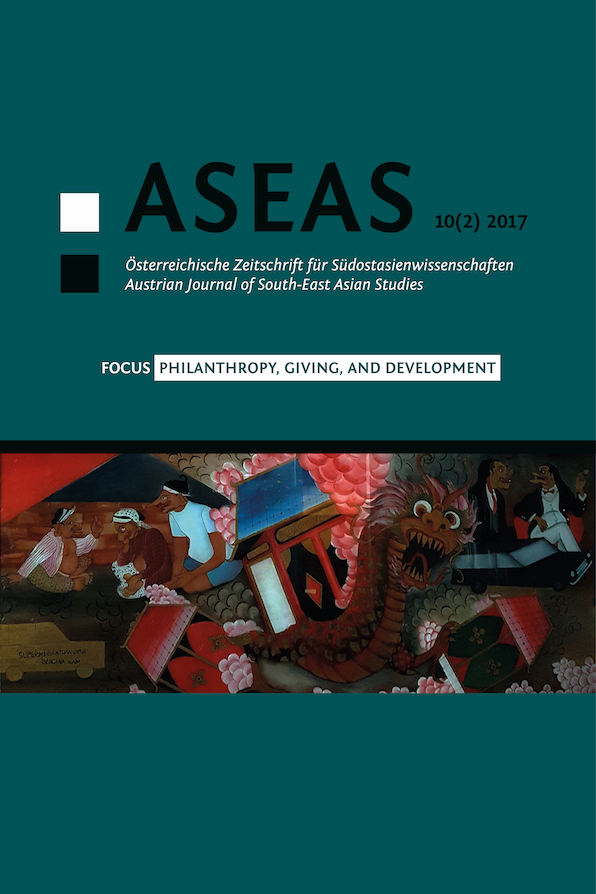
Philanthropy, Giving, and Development
Vol. 10 No. 2 (2017)ASEAS 10(2) focuses on the evolving state of philanthropy in Southeast Asia. Collectively, the contributions provide an overview of the trends and tensions in this sector, which is being shaped by often conflicting notions of charity, development, and business. Two of the articles refer to the decreasing presence and changing nature of funding from philanthropic foundations from the United States, such as the Ford Foundation and the Rockefeller Foundation. Their tradition of context-specific strategic grant-making in the region is being challenged by the paradigmatic shift underway globally, which is being triggered by the establishment of the Bill and Melinda Gates Foundation and other 'technocratic' foundations. Articles focusing on the entire region as well as on specific countries (Myanmar, Thailand, and Indonesia) highlight home-grown philanthropy and how new forms of personal and institutionalized giving are emerging as a result of a growing middleclass and accumulated wealth. Pressure is also growing on local companies and corporate actors to show a socially conscious image by funding projects and contributing to sustainable development. Professionalization of faith-based giving is further leading to new philanthropic models such as the rise of Islamic grant-making foundations in Indonesia and other countries with Muslim communities as described by two of the articles. A question running through the issue is the extent to which this growth and diversification of philanthropy is conducive to equitable and inclusive development and democratization of society.
Managing Editors: Alexander Trupp, Rainer Einzenberger
Guest Editor: Rosalia Sciortino
Cover Photo: Glass Painting "Earthquake in Yogyakarta" by Sulasno, collection O'ong Maryono & Rosalia Sciortino, photo by Rosalia Sciortino
Layout: Karl Valent
-

Gender, Ethnicity, and Environmental Transformations
Vol. 10 No. 1 (2017)ASEAS 10(1) features a focus on the interplay of gender, ethnicity, and environmental transformations in Indonesia and beyond. The articles share the general assumption that political and economic decisions always have ecological impacts and that societies have always transformed, (re-)produced, manufactured, and crafted nature along multiple lines of differentiation. The special issue brings together an interdisciplinary collection of conflicts, alliances, and strategies regarding natural resources along ethnic and gendered lines. The contributions range from the analysis of the intertwinement of gender and ethnicity in Indonesia’s mining sector, gender-specific environmental transformations among the indigenous Dayak Benuaq in Kalimantan, the impacts of indigenous land titling in a controversial national park case in Sumatra, the contradictions of an indigenous disaster risk management system in the Philippines, or the challenges of transdisciplinary cooperation between farmers and scientists to deal with environmental transformations in Indonesia. The articles highlight that gender, ethnicity, and other categories of differentiation are important in unfolding complex environmental transformations in Indonesia and beyond. Thereby, they also show the challenge of empowering marginalized groups (e.g., indigenous peoples, farmers, and women) without creating new exclusions.
Managing Editor: Melanie Pichler
Guest Editors: Kristina Großmann, Martina Padmanabhan, Suraya Afiff
Cover Photo: Kemal Yufri / Greenpeace: Coal Barge in Indonesia
Layout: Thomas Gimesi
-

New Media
Vol. 9 No. 2 (2016)ASEAS 9(2) features a focus on new media and the online-offline nexus as the site of emerging practices and identities in the interlocking fabrics of power and institutionalized relations. It thereby sheds light on the rather unorthodox ways in which digital technologies have become part of the daily dynamics of social, cultural, and political life. Contributions to this special issue range from analyses of the militarization of cyberspace through mass surveillance and surveillance by the masses, the emergence of fascist vigilante groups that operate across different social media platforms, the use of digital media as acts of political participation and digital citizenship, to the intersection of online and offline space in the expression of non-religious identities, and prevailing digital divides. The articles employ a range of analytic frames and cover a variety of aspects of digital Southeast Asia, particularly Thailand, Indonesia, and Myanmar. They highlight the complex ways in which different actors set the parameters for participation and expression in digital space in authoritarian and post-authoritarian settings. By challenging notions of technological determinism and placing emphasis on local environments, they contribute to the broader project of provincializing digital media.
Managing Editor: Dayana Lengauer
Cover Photo: Sasin Tipchai
Layout: Thomas Gimesi
-

Political Ecology and Socio-Ecological Conflicts
Vol. 9 No. 1 (2016)ASEAS 9(1) features a focus on socio-ecological conflicts from a political ecology perspective. It brings together an interdisciplinary collection of expressions of conflict over land, forests, water, mining, and environmental assets. It discusses the power relations underlying these forms of contestation as well as the strategies of different actors to deal with the unequal outcomes of environmental and resource politics. The contributions range from the analysis of land conflicts against the expansion of oil palm monocultures and other large-scale land deals, resistance against the dispossession of ethnic minorities from forest lands, the changing terrains of mining conflicts, the unequal effects of flood management to the potentials and pitfalls of indigenous mobilization against resource enclosures or the changing networks of environmental governance through green economy discourses. The articles employ different conceptions of socio-ecological conflicts (from political economy to poststructuralist assemblage theories) to understand the contested nature of resource appropriation and control in Indonesia, Thailand, Myanmar, the Philippines, and Papua New Guinea. The contributions highlight the complex and diverse forms of socio-ecological conflicts in Southeast Asia that constantly transform society-nature relations in unpredictable and often contradictory ways. Thereby they also show the transformative potential of collectively mobilizing people, even in the most marginalized and seemingly powerless contexts.
Managing Editor: Melanie Pichler
Guest Editor: Alina Brad
Cover Photo: Alexander Trupp
Layout: Thomas Gimesi
-
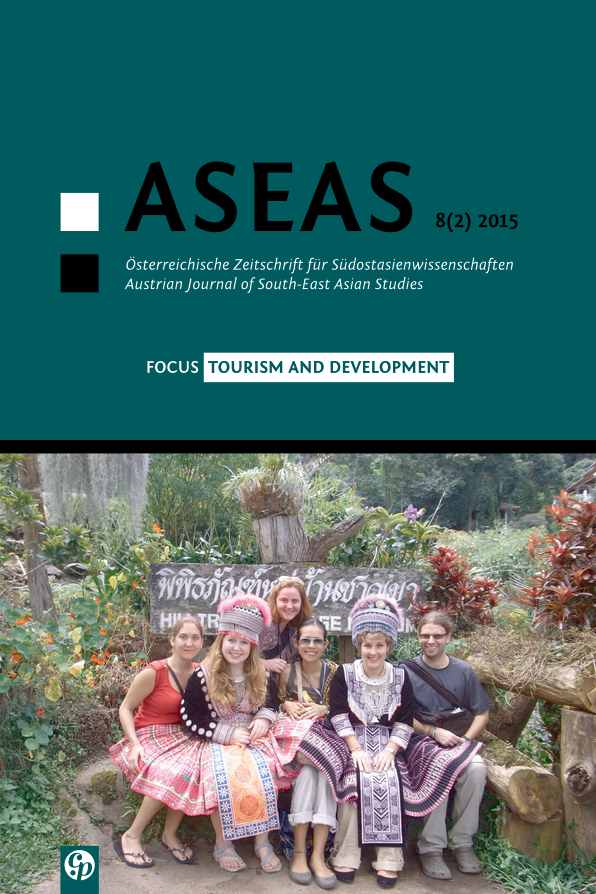
Tourism and Development
Vol. 8 No. 2 (2015)The current ASEAS issue presents critical discussions on the topic of tourism and development in Southeast Asia. Tourism in the region has caused increasing socioeconomic inequality and vast disruptions to local ecosystems, societies, and cultures, above all through its rapid expansion that often exceeds local carrying capacity limits. This is often supported through injections of capital by external funding bodies with little local initiative. At the same time, there appears to be an increasing awareness in Southeast Asian tourism that the once ‘toured’ need to experience greater levels of decision-making and power in order for tourism to work as an effective catalyst for development. Researching tourism in Southeast Asia is no longer limited to understanding its impacts as well as local responses and mitigation strategies, but now also focuses on finding practical ways for how tourism can serve as an engine for development. This issue explores a variety of concerns connected to tourism as a tool for development by discussing social marketing in Northern Vietnam, impacts of a mega event in Eastern Indonesia, host-guest encounters in community-based tourism in Northern Thailand, and commodification and politicization of heritage in the context of tourism in Hanoi, Vietnam.
Managing Editors: Claudia Dolezal & Alexander Trupp
Cover Photo: Kosita Butratana
Layout: Thomas Gimesi
-

Food Sovereignty
Vol. 8 No. 1 (2015)The current ASEAS issue presents various approaches to food sovereignty – as a political struggle as well as daily practices. Throughout the last decades, agricultural transformations have turned Southeast Asia from a food-insecure region into one characterized by high export sales in staple foods as well as investments in modern food systems. Despite the region’s achievements in food security, it is increasingly confronted with new challenges regarding the quality and the social distribution of foods. This issue aims to explore different struggles for what we may broadly call food sovereignty, based on a methodological reflection on ‘actors’ and empirical studies into such diverse settings as a remote peasant community in Indonesia, soup-pot restaurants in Phnom Penh, and a network of activists in the Northeast of Thailand promoting alternative forms of agriculture.
Guest Editors: Christiane Voßemer, Judith Ehlert
Managing Editors: Michelle Proyer, Ralph Guth
Cover Photo: Simon Benedikter
Layout: Thomas Gimesi
-

Imagining Indonesia
Vol. 7 No. 2 (2014)The present ASEAS issue features a focus on political utopias and homeland imaginaries held by Indonesians and, in one case, East Timorese at home and abroad. These include labor and marriage migrants, expatriates, overseas students, political exiles, and refugees living outside of their home country. Since being in exile does not always require an actual departure from the homeland, this special issue also takes into account the imaginaries of those who are physically within the boundaries of Indonesia, yet in one way or another voluntarily or involuntarily ‘exiled’ from the rest of society. ‘Imagining Indonesia’ aims to explore the multiple readings of longings for a better life that are projected both on Indonesia’s past and future. The papers deal with the romanticization and transfiguration of the Indonesian homeland without ignoring the darker sides of internal and external exile, migration, and long-distance politics.
Guest Editors: Antje Missbach, Henry Myrttinen
Managing Editor: Dayana Parvanova
Cover Photo: Helena Manhartsberger
Layout: Thomas Gimesi
-

Conflict Dynamics and Transformations
Vol. 7 No. 1 (2014)The present ASEAS issue features a focus on ‘Conflict Dynamics and Transformations in Southeast Asia’. It brings together topical works of researchers from various academic fields that offer a comprehensive perspective on current developments in some of the region’s political, social, and environmental conflicts as well as on approaches to their management and resolution. The contributions include case studies from Indonesia, Myanmar, the Philippines, and Thailand, as well as analyses of the status and prospects of regional security cooperation within the framework of the Association of Southeast Asian Nations (ASEAN).
Guest Editor: Gunnar Stange
Managing Editor: Iris O'Rourke
Cover Photo: Sina Kowalewski
Layout: Thomas Gimesi
-

Mobilities
Vol. 6 No. 2 (2013)In recent years, an increasing number of empirical and theoretical studies dealing with mobilities in Asia have focused on international forms of movements. Important research areas in this context are tourism and transnational migration flows. ASEAS 6(2) addresses a variety of issues concerning mobilities in South-East Asia, including case studies that involve moving people and objects in or from Indonesia, Thailand, the Philippines, and Vietnam.
Managing Editors: Alexander Trupp & Claudia Dolezal
Cover Photo: Natt Muangsiri / Two Steps Behind: Thailand Hua Lumphong Departed Bangkok
Layout: Christian Bothe
-

Social Movements
Vol. 6 No. 1 (2013)The papers of the present issue on social movements in South-East Asia shed light upon specific aspects of social activism and add knowledge to existing assumptions on the formation, organization (or institutionalization), and eventual impact of social movements in the region.
Managing Editors: Dayana Parvanova, Melanie Pichler
Cover Photo: Helena Manhartsberger: Walls of revolution: A snap from the workshop of Samijoyo Allstars, Central Java, Indonesia, 2013
Layout: Christian Bothe

